Neutral Axis Depth versus Ductility and Plastic Rotation Capacity on Bending in Lightweight-Aggregate Concrete Beams
Abstract
:1. Introduction
- using steel with suitable ductility properties for the reinforcing bars;
- ensuring a proper design for the critical sections such that the neutral axis depth at failure is small (usually characterized by parameter , with the neutral axis depth at failure and the effective depth of the longitudinal tensile reinforcement);
- using closed stirrups as transverse reinforcement, with small longitudinal spacing, to ensure a suitable confinement of concrete in the compression area of the cross-section;
- using additional longitudinal reinforcement in the compression area of the cross-section.
2. Previous Experimental Tests
3. Previous Experimental Results
3.1. Load versus Deflection Curves and Deflection Ductility Indexes
3.2. Plastic Rotation versus Deflection Curves and Plastic Trend Parameters
4. Neutral Axis Depth versus Bending Moment at the Critical Sections
5. Analysis of the Neutral Axis Depth
5.1. Evolution of the Neutral Axis Depth with Ductility and Plastic Rotation Capacity
5.2. Influence of the Longitudinal Tensile Reinforcement Ratio
5.3. Influence of the Concrete Compressive Strength
- group A, with an average longitudinal reinforcement () equal to 0.47%, including Beams 1(22.0–0.38), 1(22.4–0.55), 2(47.1–0.38), 2(49.2–0.55), 3(51.2–0.38) and 3(52.4–0.55);
- group B, with an average longitudinal reinforcement () equal to 1.21%, including Beams 1(28.5–0.99), 2(43.9–0.99), 2(47.0–1.55), 3(55.3–0.99) and 3(53.4–1.55).
6. Conclusions
- It was found that the evolution of the neutral axis depth for RC LWAC beams as the load increases is identical to the same reported and accepted for RC NWAC beams. This seems to indicate that the behavior of the formation and opening of the cracks for RC NWAC is also valid for RC LWAC;
- It was also found that both the flexural ductility and plastic rotation capacity of the RC LWAC beams increase as the neutral axis depth in failure decreases, as was also observed for RC NWAC beams. Therefore, the practical rule of limiting the neutral axis depth in the critical sections, to assure adequate flexural ductility and plastic rotation capacity levels, is also valid for RC LWAC beams;
- The results shown that the neutral axis depth in failure rises as the longitudinal tensile reinforcement ratio increases, as was observed and is accepted for RC NWAC beams. Therefore, the additional practical rule of limiting the quantity of longitudinal tensile reinforcement in the critical sections, to assure adequate flexural ductility and plastic rotation capacity levels, is also valid for RC LWAC beams;
- The results also show that the increase of concrete compressive strength seems to be favorable for both the flexural ductility and plastic rotation capacity for RC LWAC beams, since it was observed that the neutral axis depth at failure slightly decreases as the concrete compressive strength increases. However, the influence of the concrete compressive strength shown to be much lower than the longitudinal tensile reinforcement ratio;
- Finally, it was also found that the theoretical formulation from Eurocode 2 [9] based on the rectangular stress block diagram for concrete in compression, to compute the neutral axis depth at failure, does not give values approximate to those obtained from the experimental data. The theoretical values obtained were smaller when compared to those calculated experimentally. Therefore, the parameters to define the rectangular stress block as stated by Eurocode 2 [9] seems to still need to be adjusted for LWAC and some further research on this matter should be considered.
Author Contributions
Funding
Conflicts of Interest
References
- Bogas, J.A.; Gomes, A. Compressive behaviour and failure modes of structural lightweight aggregate concrete—Characterization and strength prediction. Mater. Des. 2013, 46, 832–841. [Google Scholar] [CrossRef]
- Domagala, L. Modification of properties of structural lightweight concrete with steel fibres. J. Civ. Eng. Manag. 2011, 17, 36–44. [Google Scholar] [CrossRef]
- Cui, H.Z.; Lo, T.Y.; Memon, S.A.; Xu, W. Effect of lightweight aggregate on the mechanical properties and brittleness of lightweight aggregate concrete. Constr. Build. Mater. 2012, 35, 149–158. [Google Scholar] [CrossRef]
- Jung, I.H.; Yang, W.J.; Yi, W.H.; Jee, S.W.; Lee, S.Y. Flexural Behavior of High-Strength Lightweight Concrete Beam with Eco Lightweight Aggregates. In Proceedings of the 6th International Conference on Fracture and Damage Mechanics, Madeira, Portugal, 17–19 July 2007; pp. 733–736. [Google Scholar]
- Liu, M.Y.; Lin, C.; Li, O.; Ding, Q.J.; Hu, S.G. Flexural Performance of Reinforced High-Strength Lightweight Concrete Beams. In Proceedings of the 9th International Symposium on Structural Engineering for Young Experts, Fuzhou, China, 18–21 August 2006; pp. 264–270. [Google Scholar]
- Bernardo, L.F.A.; Nepomuceno, M.C.S.; Pinto, H.A.S. Flexural ductility of lightweight-aggregate concrete beams. J. Civ. Eng. Manag. 2016, 22, 622–633. [Google Scholar] [CrossRef]
- Bernardo, L.F.A.; Nepomuceno, M.C.S.; Pinto, H.A.S. Plastic rotation capacity of lightweight-aggregate concrete beams. J. Civ. Eng. Manag. 2016, 22, 1032–1041. [Google Scholar] [CrossRef]
- Sin, L.H.; Huan, W.T.; Islam, M.R.; Mansur, M.A. Reinforced lightweight concrete beams in flexure. ACI Struct. J. 2010, 108, 3–12. [Google Scholar]
- NP EN 1992-1-1. 2010. Eurocode 2: Design of Concrete Structures-Part 1: General Rules and Rules for Building; European Committee for Standardization—CEN: Brussels, Belgium, 2010.
- Bernardo, L.F.A.; Lopes, S.M.R. Neutral axis depth versus flexural ductility in high strength concrete beams. J. Struct. Eng. 2004, 130, 452–459. [Google Scholar] [CrossRef]
- Bernardo, L.F.A.; Lopes, S.M.R. Flexural ductility of HSC beams. Struct. Concr. 2003, 4, 135–154. [Google Scholar] [CrossRef]

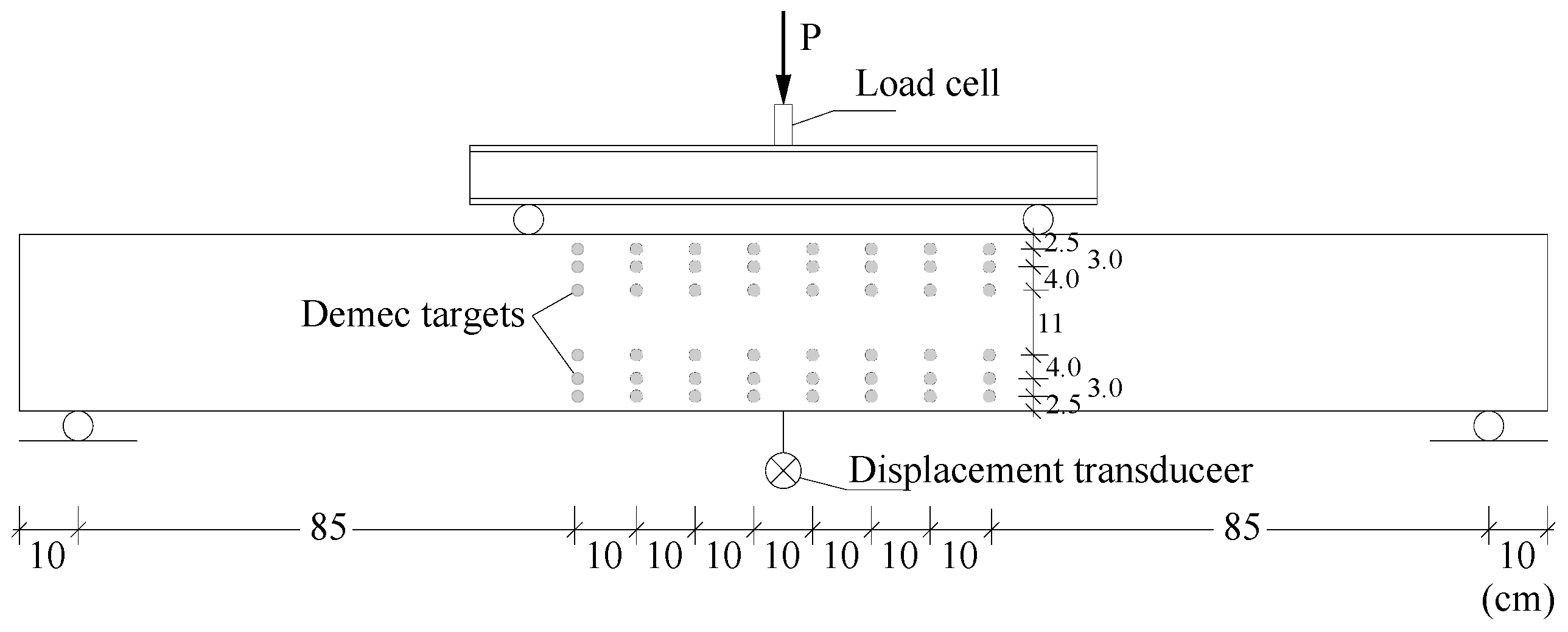



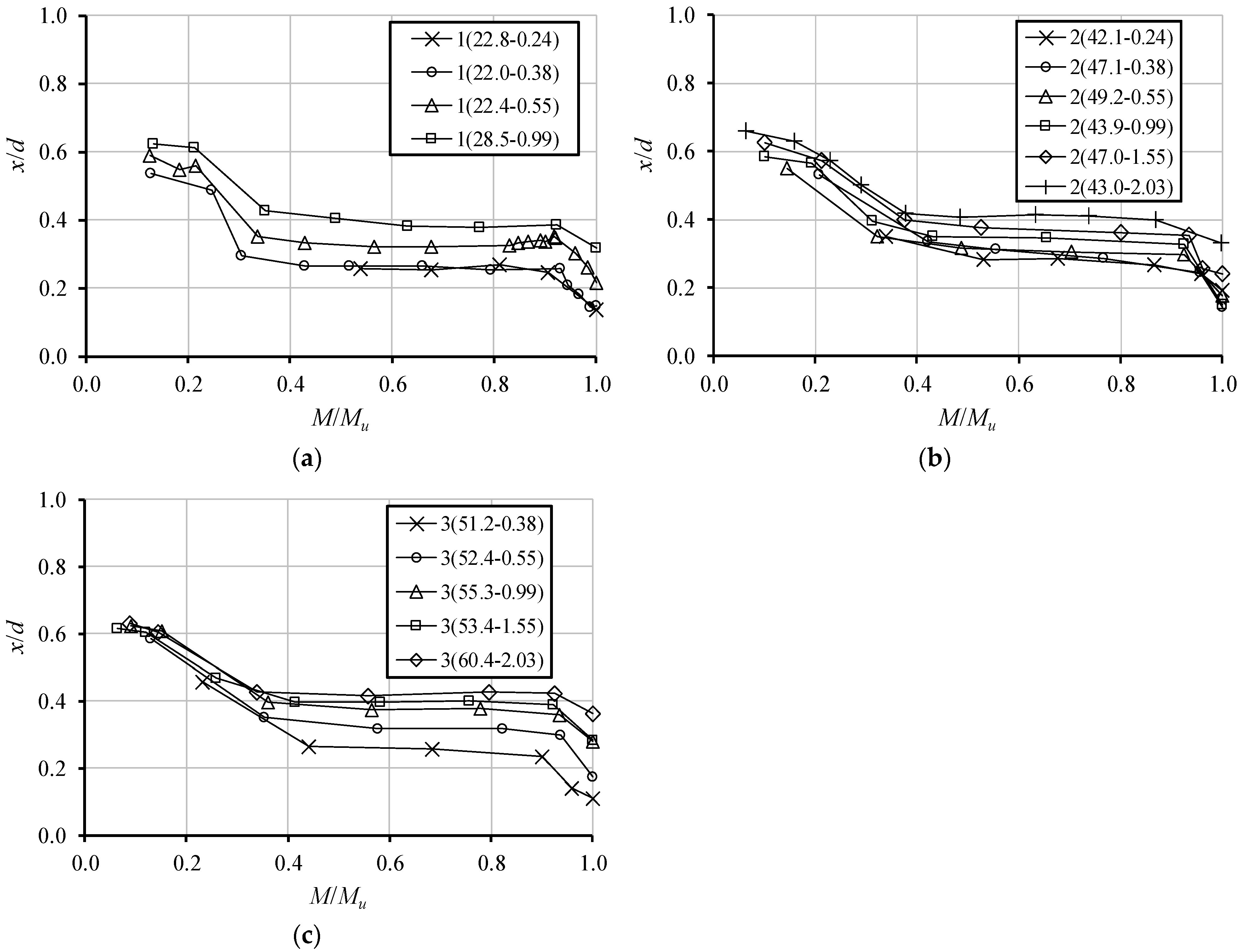
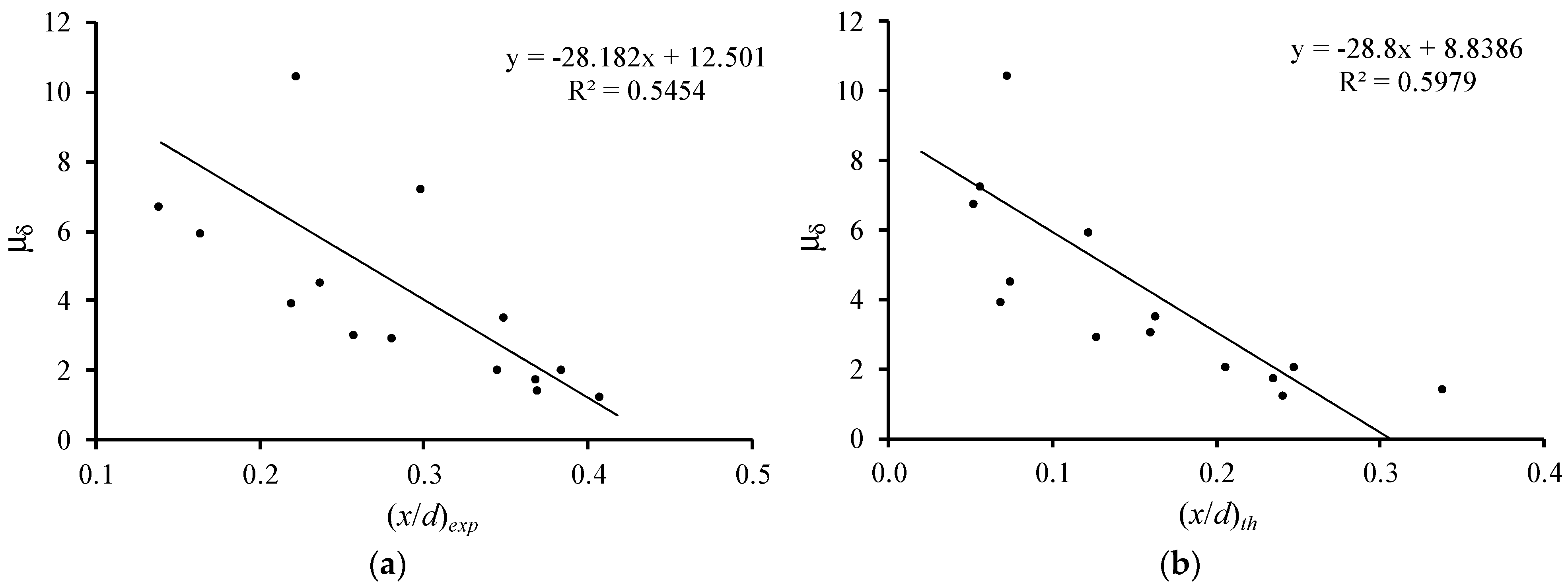

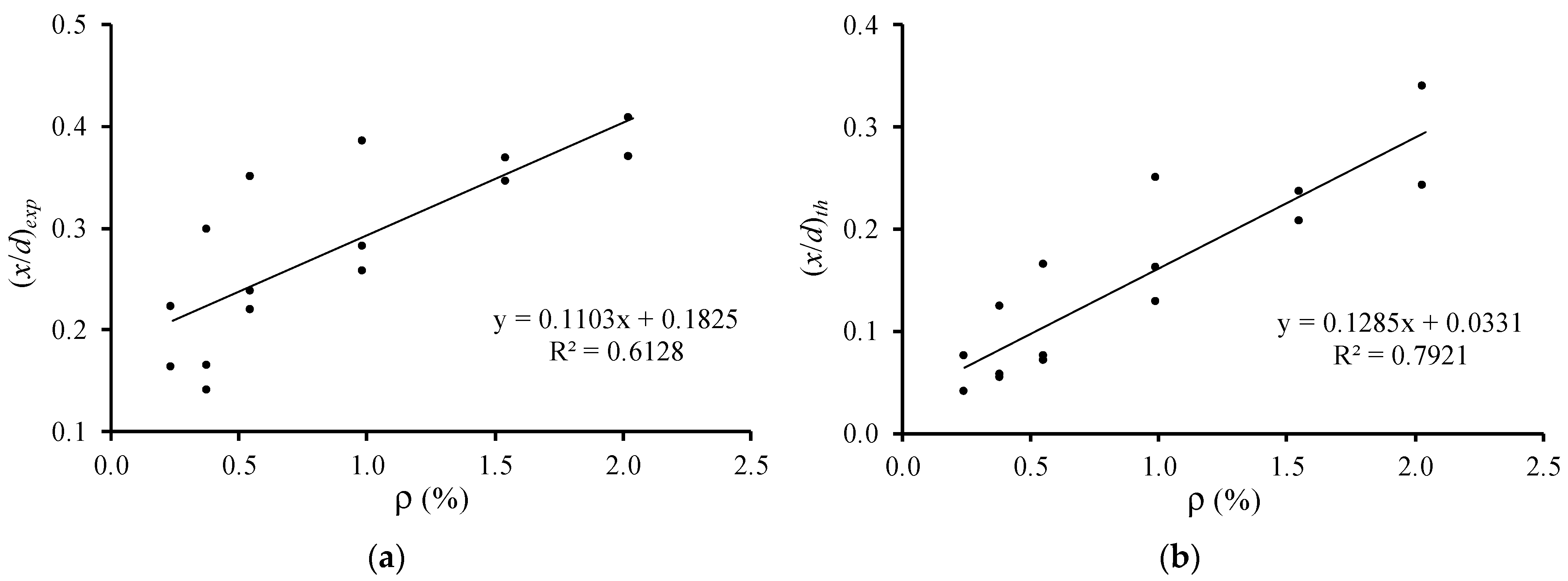
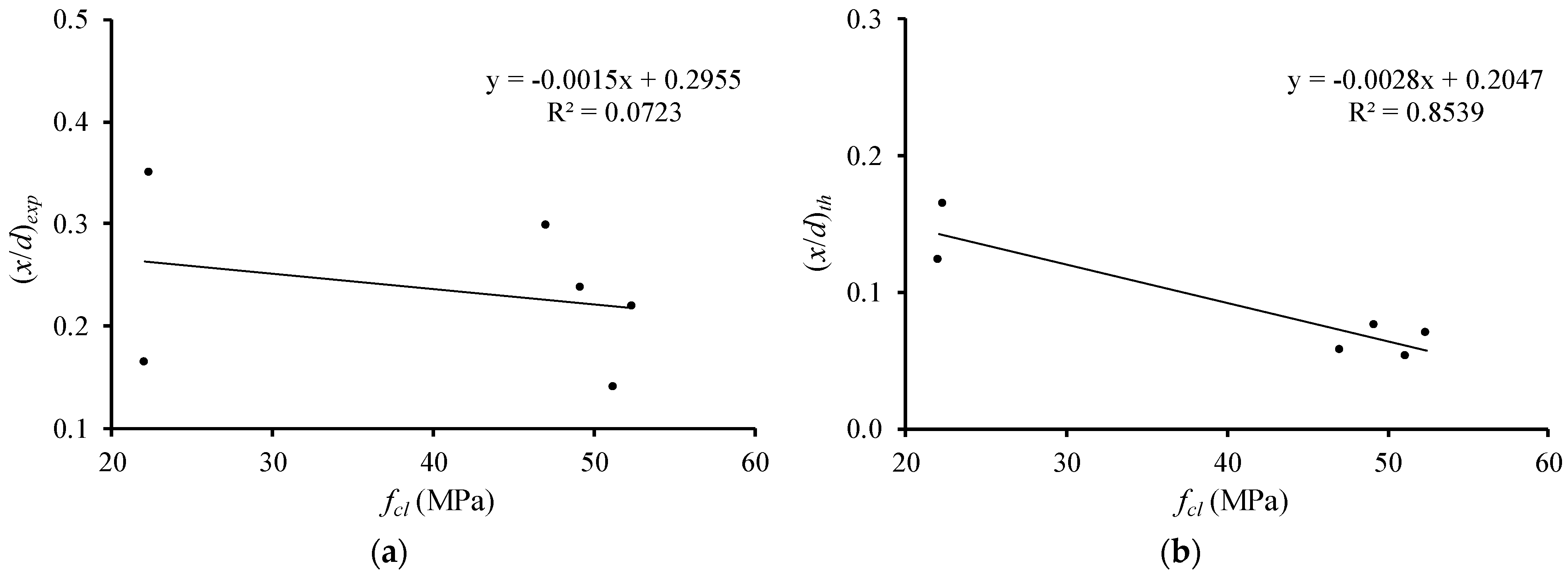
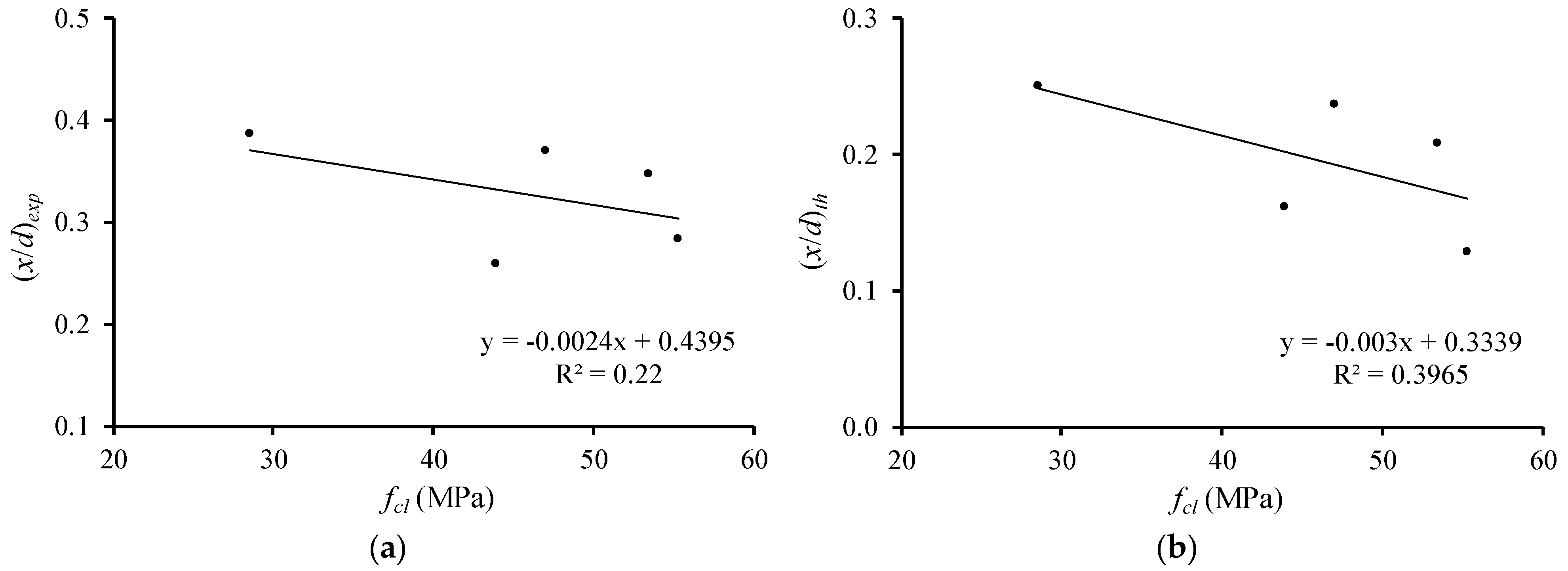
| Beam | MPa | kg/m3 | cm2 | cm | % |
|---|---|---|---|---|---|
| 1(23.5–0.13) | 23.5 | 1659 | 0.56 (2ϕ6) | 27.7 | 0.13 |
| 1(22.8–0.24) | 22.8 | 1685 | 1.01 (2ϕ8) | 27.6 | 0.24 |
| 1(22.0–0.38) | 22.0 | 1667 | 1.58 (2ϕ10) | 27.5 | 0.38 |
| 1(22.4–0.55) | 22.4 | 1651 | 2.26 (2ϕ12) | 27.4 | 0.55 |
| 1(28.5–0.99) | 28.5 | 1659 | 4.02 (2ϕ16) | 27.2 | 0.99 |
| 2(45.1–0.13) | 45.1 | 1802 | 0.56 (2ϕ6) | 27.7 | 0.13 |
| 2(42.1–0.24) | 42.1 | 1807 | 1.01 (2ϕ8) | 27.6 | 0.24 |
| 2(47.1–0.38) | 47.1 | 1809 | 1.58 (2ϕ10) | 27.5 | 0.38 |
| 2(49.2–0.55) | 49.2 | 1827 | 2.26 (2ϕ12) | 27.4 | 0.55 |
| 2(43.9–0.99) | 43.9 | 1788 | 4.02 (2ϕ16) | 27.2 | 0.99 |
| 2(47.0–1.55) | 47.0 | 1791 | 6.28 (2ϕ20) | 27.0 | 1.55 |
| 2(43.0–2.03) | 43.0 | 1790 | 8.04 (4ϕ16) | 26.4 | 2.03 |
| 3(52.1–0.13) | 52.1 | 1867 | 0.56 (2ϕ6) | 27.7 | 0.13 |
| 3(51.2–0.38) | 51.2 | 1879 | 1.58 (2ϕ10) | 27.5 | 0.38 |
| 3(52.4–0.55) | 52.4 | 1869 | 2.26 (2ϕ12) | 27.4 | 0.55 |
| 3(55.3–0.99) | 55.3 | 1910 | 4.02 (2ϕ16) | 27.2 | 0.99 |
| 3(53.4–1.55) | 53.4 | 1877 | 6.28 (2ϕ20) | 27.0 | 1.55 |
| 3(60.4–2.03) | 60.4 | 1953 | 8.04 (4ϕ16) | 26.4 | 2.03 |
| 3(51.6–2.69) | 51.6 | 1867 | 10.30 (2ϕ16 + 2ϕ20) | 25.5 | 2.69 |
| Constituent Materials | Series 1 | Series 2 | Series 3 |
|---|---|---|---|
| Portland cement 1 (kg): CEM II/B-L32.5N | 335 | - | - |
| Portland cement 2 (kg): CEM I 42.5R | - | 445 | 494 |
| Mineral addition 1 (kg): Limestone powder | - | - | 35 |
| Mineral addition 2 (kg): Microsilica | - | - | 43 |
| Superplasticizer (liters) | 1.34 | 5.34 | 9.88 |
| Water (liters) | 174 | 146 | 153 |
| Natural fine aggregate, Sand 0/5 (kg) | 841 | 756 | 775 |
| Lightweight coarse aggregate, Leca 4/12 (kg) | 463 | 501 | 426 |
| Water-binder ratio (in mass) | 0.52 | 0.33 | 0.29 |
| Beam | PTP % | (x/d)exp | (x/d)th | |
|---|---|---|---|---|
| 1(22.8–0.24) | 10.4 | 9.8 | 0.223 | 0.074 |
| 1(22.0–0.38) | 5.9 | 5.8 | 0.165 | 0.123 |
| 1(22.4–0.55) | 3.5 | 3.2 | 0.350 | 0.164 |
| 1(28.5–0.99) | 2.0 | 1.8 | 0.385 | 0.249 |
| 2(42.1–0.24) | 12.4 | 11.2 | 0.163 | 0.040 |
| 2(47.1–0.38) | 7.2 | 6.9 | 0.299 | 0.057 |
| 2(49.2–0.55) | 4.5 | 4.4 | 0.238 | 0.075 |
| 2(43.9–0.99) | 3.0 | 2.7 | 0.258 | 0.161 |
| 2(47.0–1.55) | 1.7 | 1.5 | 0.369 | 0.236 |
| 2(43.0–2.03) | 1.4 | 0.9 | 0.370 | 0.339 |
| 3(51.2–0.38) | 6.7 | 6.5 | 0.140 | 0.053 |
| 3(52.4–0.55) | 3.9 | 3.8 | 0.220 | 0.070 |
| 3(55.3–0.99) | 2.9 | 2.6 | 0.282 | 0.128 |
| 3(53.4–1.55) | 2.0 | 1.9 | 0.346 | 0.207 |
| 3(60.4–2.03) | 1.2 | 0.9 | 0.408 | 0.242 |
| 3(51.6–2.69) | ≈1.0 | ≈0 | 0.585 | 0.374 |
© 2019 by the authors. Licensee MDPI, Basel, Switzerland. This article is an open access article distributed under the terms and conditions of the Creative Commons Attribution (CC BY) license (http://creativecommons.org/licenses/by/4.0/).
Share and Cite
Bernardo, L.; Nepomuceno, M.; Pinto, H. Neutral Axis Depth versus Ductility and Plastic Rotation Capacity on Bending in Lightweight-Aggregate Concrete Beams. Materials 2019, 12, 3479. https://doi.org/10.3390/ma12213479
Bernardo L, Nepomuceno M, Pinto H. Neutral Axis Depth versus Ductility and Plastic Rotation Capacity on Bending in Lightweight-Aggregate Concrete Beams. Materials. 2019; 12(21):3479. https://doi.org/10.3390/ma12213479
Chicago/Turabian StyleBernardo, Luís, Miguel Nepomuceno, and Hugo Pinto. 2019. "Neutral Axis Depth versus Ductility and Plastic Rotation Capacity on Bending in Lightweight-Aggregate Concrete Beams" Materials 12, no. 21: 3479. https://doi.org/10.3390/ma12213479
APA StyleBernardo, L., Nepomuceno, M., & Pinto, H. (2019). Neutral Axis Depth versus Ductility and Plastic Rotation Capacity on Bending in Lightweight-Aggregate Concrete Beams. Materials, 12(21), 3479. https://doi.org/10.3390/ma12213479








